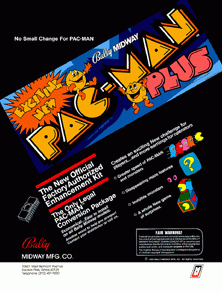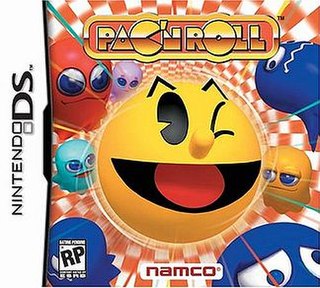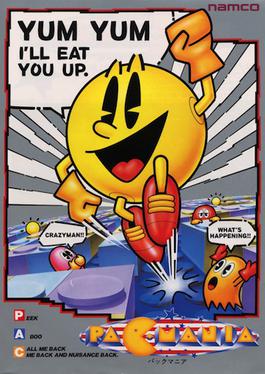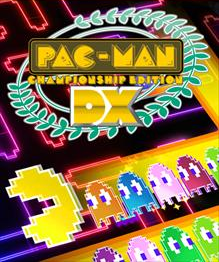
Pac-Man, originally called Puck Man in Japan, is a 1980 maze video game developed and published by Namco for arcades. In North America, the game was released by Midway Manufacturing as part of its licensing agreement with Namco America. The player controls Pac-Man, who must eat all the dots inside an enclosed maze while avoiding four colored ghosts. Eating large flashing dots called "Power Pellets" causes the ghosts to temporarily turn blue, allowing Pac-Man to eat them for bonus points.

Ms. Pac-Man is a maze arcade video game developed by General Computer Corporation and published by Midway in 1982. It is a sequel to Pac-Man (1980) and the first entry in the series to not be made by Namco. Controlling the title character, Pac-Man's wife, the player is tasked with eating all of the pellets in an enclosed maze while avoiding four colored ghosts. Eating the larger "power pellets" lets the player eat the ghosts, which turn blue and flee.

Pac-Man Vs. is a 2003 maze video game developed by Nintendo and published by Namco for the GameCube. In the game, one player takes control of Pac-Man, who must eat all of the pellets in the maze, while the others control the ghosts to try to catch them. The objective is to be the first to reach a set number of points, selected before the game begins. The player controlling Pac-Man uses the Game Boy Advance to play, while the others use the television to control the ghosts. The game requires the GameCube - Game Boy Advance link cable in order to play.

Pac-Man Plus is an arcade game that was developed by Namco and released by Bally Midway in 1982. It is part of the Pac-Man series of games.

Pac-Land is a 1984 platform video game developed and published by Namco for arcades. It was distributed in North America by Bally Midway, and in Europe by Atari Games. Controlling Pac-Man, the player must make it to the end of each stage to return a lost fairy back to its home in Fairyland. Pac-Man will need to avoid obstacles, such as falling logs and water-spewing fire hydrants, alongside his enemies, the Ghost Gang. Eating large flashing Power Pellets will cause the ghosts to turn blue, allowing Pac-Man to eat them for points.

Super Pac-Man is a 1982 maze video game developed and published by Namco for arcades. It is an official sequel to the original Pac-Man; Midway had previously commissioned General Computer Corporation to develop an unofficial sequel Ms. Pac-Man, which Namco had little involvement with beyond licensing. Toru Iwatani returns as designer.

Pac 'n Roll is a 2005 platform video game developed and published by Namco for the Nintendo DS. The game features a 3D Pac-Man that players control by rolling him through the playing field using the touchscreen. Transformed into a ball, Pac-Man embarks on a journey with his fairy companion, Krystal, to rescue his friends from Golvis and the ghosts.

Pac-Man World is a platform video game developed and published by Namco Hometek for the PlayStation. Controlling Pac-Man, the player must complete each of the game's six worlds by collecting keys to free his captive family members, and reaching the end of each stage. The plot follows Pac-Man's enemies, the ghosts, crashing his 20th birthday and kidnapping his friends and family to bring them to their homeland of Ghost Island — with his birthday in ruins and his family in trouble, Pac-Man sets out to rescue them and defeat the ghosts.

Namco Classic Collection Vol. 2 is a 1996 compilation arcade game developed and published by Namco. It is a collection of four of Namco's popular games: Pac-Man (1980), Rally-X (1980), New Rally-X (1981) and Dig Dug (1982). Alongside the original games, three new "Arrangement" games based on each game are included.
Pac-Man is a video game series and media franchise developed, published and owned by Bandai Namco Entertainment, a video game publisher that was previously known as Namco. Entries have been developed by a wide array of other video game companies, including Midway Games, Atari and Mass Media, Inc., and was created by Toru Iwatani. The eponymous first entry was released in arcades in 1980 by Namco, and published by Midway Games in North America. Most Pac-Man games are maze chase games, but it has also delved into other genres, such as platformers, racing, and sports. Several games in the series were released for a multitude of home consoles and are included in many Bandai Namco video game compilations, The franchise contains 2 animated series and an upcoming film.

Pac-Mania is a 1987 maze video game developed and published by Namco for arcades. In the game, the player controls Pac-Man as he must eat all of the dots while avoiding the colored ghosts that chase him in the maze. Eating large flashing "Power Pellets" will allow Pac-Man to eat the ghosts for bonus points, which lasts for a short period of time. A new feature to this game allows Pac-Man to jump over the ghosts to evade capture. It is the ninth title in the Pac-Man video game series and was the last one developed for arcades up until the release of Pac-Man Arrangement in 1996. Development was directed by Pac-Man creator Toru Iwatani. It was licensed to Atari Games for release in North America.

Pac-Man Championship Edition is a 2007 maze video game developed and published by Namco Bandai Games for the Xbox 360. It has since been released on several other platforms, including iOS, Android, and the PlayStation Portable as a PSP mini title available on the PlayStation Store. It is an HD reimagining of Namco's original Pac-Man arcade game; players navigate Pac-Man through an enclosed maze, eating pellets and avoiding four ghosts that pursue him. Clearing an entire side of the maze of dots will cause a fruit item to appear, and eating it will cause a new maze to appear on the opposite side.

Pac-Man is a fictional character and the titular protagonist of Bandai Namco Entertainment's video game franchise of the same name. Created by Toru Iwatani, he first appeared in the arcade game Pac-Man (1980), and has since appeared in more than 30 licensed sequels and spin-offs for multiple platforms, and spawning mass amounts of merchandise in his image, including two television series and a hit single by Buckner & Garcia. He is the official mascot of Bandai Namco Entertainment. Pac-Man's most common antagonists are the Ghost Gang — Blinky, Pinky, Inky and Clyde that are determined to defeat him to accomplish their goals, which change throughout the series. Pac-Man also has a voracious appetite, being able to consume vast amounts of food in a short timespan, and can eat his enemies by consuming large "Power Pellets".

Pac-Man Championship Edition DX is a 2010 maze video game developed by Chinese studio Mine Loader Software and published by Namco Bandai Games for the Xbox 360 and PlayStation 3, later ported to Steam, Android and iOS. It is the sequel to the 2007 game Pac-Man Championship Edition, which was the last game developed by series creator Toru Iwatani. The player controls Pac-Man as he must eat all of the dots in the maze while avoiding colored ghosts that pursue him. A bonus item will appear once the player has eaten all dots on one side of the maze, causing the layout to change. Several additions were made over the original, such as bombs that send all ghosts to the regeneration box and sleeping ghosts that will give chase when Pac-Man moves past them.

World's Biggest Pac-Man is a browser game created by Australian website designer Soap Creative along with Microsoft and Namco Bandai Games. It is a Pac-Man game which differed from the original by having multiple players play together in a series of user-created, customizable and interlocking mazes. The game was announced at the Microsoft MIX Developer Conference on 13 April 2011.

Pac-Man 256 is an endless runner video game developed by Hipster Whale and 3 Sprockets and published by Bandai Namco Entertainment. The game is part of the Pac-Man series and is inspired by the original Pac-Man game's infamous Level 256 glitch, as well as Hipster Whale's own game Crossy Road, which previously featured a Pac-Man mode. The game was originally released as a free-to-play title for iOS and Android on August 20, 2015. In June 21, 2016, Bandai Namco released a version of the game for the PlayStation 4, Xbox One, and PC, featuring additional features like multiplayer for up to 4 players, a new power-up, and no longer having to wait a certain amount of time to get power-ups, and instead having to eat a number of Pac-Dots.

Pac-Man Championship Edition 2 is a maze arcade game developed by Bandai Namco Studios and published by Bandai Namco Entertainment. An installment in the Pac-Man series, it was released for PlayStation 4, Windows, and Xbox One on September 15, 2016; an updated version featuring an exclusive 2-player co-op mode, Pac-Man Championship Edition 2 Plus, was released for Nintendo Switch on February 22, 2018. It is a direct sequel to Pac-Man Championship Edition and the follow-up of Pac-Man Championship Edition DX+.

The Pac-Man 40th Anniversary was a celebration of the Pac-Man series of video games since the release of the arcade cabinet Pac-Man on May 22, 1980. Bandai Namco celebrated the anniversary through business ventures with video games, events, clothing and other forms of merchandise. The anniversary took place throughout 2020, and ended in early 2021.
Pac-Man Mega Tunnel Battle is a battle royale maze game developed by Heavy Iron Studios. The game was originally released for Google Stadia on November 17, 2020. On January 18, 2023, the game was shut down when Stadia ended its service. On October 10, 2023, Bandai Namco announced an expanded version of the game called Pac-Man Mega Tunnel Battle: Chomp Champs, which was released on Nintendo Switch, Microsoft Windows, PlayStation 5, PlayStation 4, and Xbox Series X/S on May 9, 2024.

Pac-Man 99 was a maze video game with battle royale elements developed by Arika and published by Bandai Namco Entertainment for the Nintendo Switch. It was released through the Nintendo Switch Online service on April 7, 2021.


















